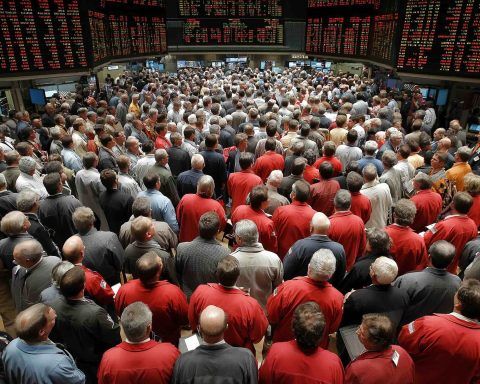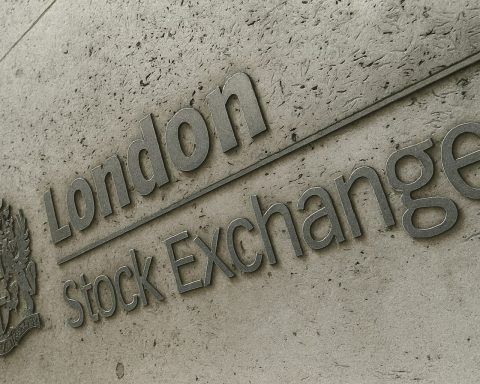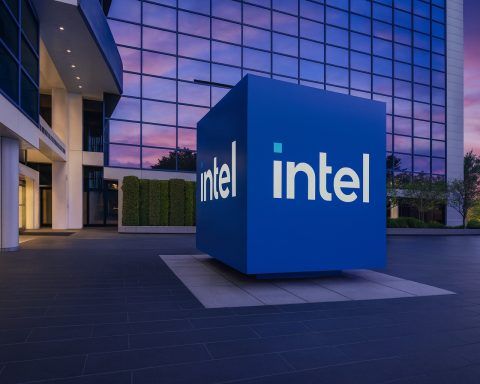Ford Motor Company (NYSE: F) cuts the ribbon on a futuristic world headquarters in Dearborn, even as it recalibrates its EV strategy and investors weigh record earnings against supply shocks and tariffs.
A landmark day for Ford in Dearborn
Ford Motor Company has officially moved into its new world headquarters in Dearborn, Michigan, marking the automaker’s first headquarters shift in nearly 70 years and the symbolic centerpiece of its Ford+ transformation plan. [1]
The new complex, known as the Henry Ford II World Center, replaces the iconic “Glass House,” which has served as Ford’s global nerve center since the 1950s. The move puts design, engineering, technology and corporate leadership under one vast roof and is meant to signal that Ford now sees itself as a software- and data-driven mobility company as much as a traditional automaker. [2]
At the same time, Ford is working through a complicated mix of opportunities and headwinds:
- A record third quarter, but a cut to full‑year guidance after a fire at key supplier Novelis. [3]
- Tariff relief that could shrink cost pressures more than feared. [4]
- An EV strategy reshaped by lessons from Tesla and surging competition from China. [5]
- A stock that is up more than 30% year‑to‑date in 2025, keeping Ford firmly on investors’ radar. [6]
Here’s what today’s developments mean for Ford customers, employees and shareholders.
Inside Ford’s new 2.1 million‑square‑foot world headquarters
The new headquarters, officially opened today in Dearborn, spans roughly 2.1 million square feet—more than twice the size of the Glass House—and is designed for about 4,000 onsite employees once fully ramped by 2027. [7]
Key features highlighted by Ford and local media include:
- Campus-scale collaboration: Thousands of engineering, design, technology and corporate staff are now clustered in one connected complex, with a broader 14,000 employees within about a 15‑minute walk, dramatically shrinking the distance between teams that once worked in separate buildings. [8]
- A massive food and social hub: A new food hall of around 160,000 square feet replaces the former lobby‑and‑café setup in the Glass House, part of Ford’s push to make the building a daily destination rather than just an office tower. [9]
- Showroom “crown jewel”: A large, high‑visibility showroom in the heart of the building showcases concept and production vehicles—early coverage highlighted Bronco concepts as centerpieces—doubling as both design theatre and brand statement for visitors and employees. [10]
- Green and walkable design: The campus adds green space and courtyards and is laid out to cut material‑movement time across the site by more than 80%, blending aesthetics with manufacturing‑style efficiency. [11]
The project, estimated at about $1.2 billion, sits on the historic site of Ford’s 1953 Product Development Center, where vehicles like the Mustang and F‑150 were first conceived—an intentional link between Ford’s legacy and its ambitions for the next century. [12]
The old Glass House will be decommissioned and eventually demolished over roughly an 18‑month period once employees complete the transition, with Ford and the City of Dearborn still working on future uses for the site. [13]
Signaling a tech‑centric future
Analysts and company executives alike frame the building as more than an architectural upgrade. It is intended to be a talent magnet for software engineers, AI specialists and data scientists—exactly the skills Ford needs as vehicles become rolling computers. [14]
University of Michigan business experts quoted in coverage of the opening noted that Ford wants to be seen as a future‑oriented company, not “the car company from yesterday,” and that a modern campus helps it compete with tech firms for digital talent. [15]
Internally, Ford leaders Bill Ford and Jim Farley described the headquarters earlier this year as a “physical symbol” of the company’s Ford+ strategy: moving faster, breaking down silos, and behaving more like a tech company in how products are developed and updated over time. [16]
EV strategy: lessons from Tesla and China
On the same day the new HQ opens, Ford’s evolving EV strategy is back in the spotlight thanks to new remarks from CEO Jim Farley.
In a fresh interview highlighted by EV Magazine, Farley described being “shocked” when Ford engineers tore down Tesla and Chinese EVs and realized how far ahead rivals were in areas like electronics and wiring. [17]
A few takeaways from Farley’s comments:
- Brutal economics: Farley acknowledged that plunging into EVs was always going to be financially painful in the short term, pointing to losses in the Model e division that exceeded $5 billion in 2024 and continued pressure in 2025. [18]
- Design simplification: When comparing a Tesla Model 3 to Ford’s Mustang Mach‑E, executives found Ford’s wiring harness was around 1.6 kilometers longer, effectively forcing the battery to haul unnecessary weight and cost—insight that’s pushing Ford to radically simplify future EV designs. [19]
- Global EV race: Farley reiterated that nearly half of new cars sold in China are now electric, versus roughly one in ten in the U.S., and warned that Western automakers can’t “cede” the EV future to Chinese brands. [20]
- Focus on affordability: While much of the industry once chased high‑priced $70,000–$80,000 EVs, Farley stressed that demand is shifting to affordable electric models, aligning with Ford’s work on a universal EV platform for lower‑cost vehicles scheduled to launch later this decade. [21]
These remarks come as outside commentary questions whether Ford is quietly reshaping its EV lineup—particularly the future of the F‑150 Lightning and other flagship projects—amid ongoing losses and a more selective approach to capital spending. [22]
Financial backdrop: record Q3, guidance cut and tariff relief
Behind the headlines about sleek glass walls and EV strategy is a very real tug‑of‑war in Ford’s financials.
Record Q3 results
On October 23, Ford reported record third‑quarter revenue of about $50.5 billion, up roughly 9% year‑over‑year. Net income came in near $2.4 billion, with adjusted EBIT of about $2.6 billion, essentially flat versus the prior year despite a $700 million hit from tariffs. [23]
The company also reaffirmed its focus on:
- Higher‑margin trucks and commercial vehicles
- A growing mix of hybrids
- Tight cost and quality controls after high warranty expenses in prior years [24]
Ford declared a fourth‑quarter regular dividend of $0.15 per share, payable December 1 to shareholders of record on November 7. [25]
Novelis fire and guidance cut
The strong quarter came with a major caveat: a fire at a Novelis aluminum plant in New York disrupted supply of material used in Ford’s high‑margin F‑150 and Super Duty trucks. Ford now expects the incident to shave $1.5–$2.0 billion off 2025 profit and cost up to 100,000 units of lost production in the fourth quarter alone. [26]
As a result, Ford trimmed its 2025 adjusted EBIT outlook to $6.0–$6.5 billion, down from a prior $6.5–$7.5 billion range, even as it pledges to recover around $1 billion of lost profit in 2026 by ramping truck output by more than 50,000 units once supply normalizes. [27]
Tariff costs lower than feared
One bright spot: new analyses of U.S. auto tariffs note that Ford now expects its tariff bill to be about $1 billion, roughly half its original estimate. That reduction, helped in part by the Trump administration’s recent order providing tariff credits to automakers, suggests some relief to Ford’s cost structure compared with early 2025 fears. [28]
Ford stock today: momentum with a value‑stock twist
As of the latest close, Ford Motor Company (NYSE: F) shares trade around $13.19, down modestly on the day but still significantly higher than at the start of the year.
According to Simply Wall St, Ford’s stock:
- Is up about 1.5% in the last week
- Has climbed roughly 15.8% over the past month
- Is up about 36.9% year‑to‑date in 2025 [29]
Analysts remain split on valuation:
- A discounted cash‑flow model from Simply Wall St pegs Ford’s intrinsic value well below the current share price, implying the stock might be overvalued on long‑term cashflow assumptions. [30]
- On the other hand, Ford trades at a price‑to‑earnings ratio near 11x, well under many auto peers, suggesting room for upside if earnings hold up and EV losses narrow over time. [31]
Institutional flows are mixed. A recent MarketBeat review of regulatory filings shows KBC Group NV cut its Ford stake by nearly 80% in Q2, even as the company maintains a dividend that currently yields around 4–5%, depending on share price. [32]
None of this constitutes investment advice; investors should consider their own objectives and risk tolerance or consult a licensed professional before making trading decisions.
What to watch next
Today’s headquarter opening is highly visible, but it is just one piece of Ford’s 2025 narrative. Looking ahead, key storylines include:
- HQ ramp‑up: How quickly Ford can fully populate the Henry Ford II World Center and whether the promised collaboration and efficiency gains materialize in product development timelines and cost metrics. [33]
- EV turnaround: Progress on Ford’s universal EV platform and its ability to deliver truly affordable EVs at profit—while potentially reshaping or pruning existing models like the F‑150 Lightning. [34]
- Tariffs and supply chains: The extent to which tariff relief and supply diversification can offset the Novelis disruption and reduce Ford’s exposure to single‑point failures in critical materials. [35]
- Capital allocation: Whether Ford continues balancing heavy investment in EVs and software with shareholder returns via dividends—and potentially buybacks—amid ongoing market volatility. [36]
For now, November 16, 2025 stands out as a milestone date: Ford has new glass walls, new financial realities, and a clearer sense of what it must do to compete in a world where cars, code and capital markets are more intertwined than ever.
References
1. apnews.com, 2. www.fromtheroad.ford.com, 3. docs.publicnow.com, 4. finviz.com, 5. evmagazine.com, 6. simplywall.st, 7. apnews.com, 8. www.fromtheroad.ford.com, 9. www.wxyz.com, 10. apnews.com, 11. www.wxyz.com, 12. www.wxyz.com, 13. www.fromtheroad.ford.com, 14. wtop.com, 15. wtop.com, 16. www.fromtheroad.ford.com, 17. evmagazine.com, 18. evmagazine.com, 19. evmagazine.com, 20. evmagazine.com, 21. evmagazine.com, 22. www.fool.com, 23. docs.publicnow.com, 24. www.alpha-sense.com, 25. investingnews.com, 26. www.reuters.com, 27. www.reuters.com, 28. finviz.com, 29. simplywall.st, 30. simplywall.st, 31. simplywall.st, 32. www.marketbeat.com, 33. www.wxyz.com, 34. www.fromtheroad.ford.com, 35. finviz.com, 36. www.businesswire.com








